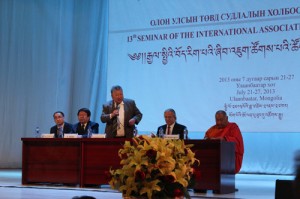By Thubten Samphel
13th Seminar of the International Association for Tibetan Studies Attracts 640 Paper Presentations
 The 13th seminar of the International Association for Tibetan Studies drew the brightest luminaries of Tibetan studies across the world. The biggest ever conference of Tibetology kicked off with a grand start in the Mongolian capital of Ulaanbaatar on 21 July. The organisers said that there were 730 applications and 640 presentations packed into a seven-day conference.
The 13th seminar of the International Association for Tibetan Studies drew the brightest luminaries of Tibetan studies across the world. The biggest ever conference of Tibetology kicked off with a grand start in the Mongolian capital of Ulaanbaatar on 21 July. The organisers said that there were 730 applications and 640 presentations packed into a seven-day conference.
The magnitude of the conference and the diversity of the topics covered by the 13th seminar of the International Association for Tibetan Studies is clearly revealed by the programme of the conference which runs into 112 densely packed pages. It seems that the organisers of the conference left no aspect of Tibet’s Buddhist civilization left un-touched or un-discussed. How the organisers will hammer out the publication of these proceedings will test their scholarship and cataloguing skill.The point the organisers stressed in the opening ceremony was the relations which Tibet developed with Mongolia, based on Buddhism which the Tibetans took upon themselves to spread to Mongolia starting from the time of Genghis Khan and culminating in the enthronement of the great Fifth Dalai Lama in 1642. As the Khamba Lama, currently Mongolia’s foremost Buddhist leader, said, “Genghis Khan established the great Mongol state in 1206. He visited Tibet to invite Tibetan lamas to Mongolia.” The Khamba Lama said in his opening address, “I am extremely happy that Buddhism is attracting the attention of the world and followers and devotees are increasing. Buddhism has made unparalleled contribution to the development of the Mongol identity and culture.”
Because the conference is being held in Mongolia, the organisers made it a point to stress how the contacts between Tibet and Mongolia contributed to the cultural development of the Mongolians. As one of the organisers said, “Since ancient times, Tibetans were the Dharma brothers of the Mongols. Cooperation in translation and compilation in a major Mongol-Tibetan dictionary was close and extensive.”
As an indication of the burgeoning Mongolian interest in Tibetan studies, the opening ceremony of the conference saw the launch of the Mongolian Association for Tibetan Studies headed by a gifted Mongolian scholar of Tibetan studies.
The 13th conference of Tibetan studies was hosted by the National University of Mongolia, the Mongolian Academy of Sciences and organised by the International Association for Tibetan Studies (IATS). In his address, Charles Rambles, the outgoing president of the IATS said, “Mongolian cooperation for the conference is inspiring and will improve studies in the area.”
Charles Rambles was highly satisfied with the turnover of the conference. He said, “With 63 panels and sessions …, the seminar has assumed a scale and scope that it would have been difficult to imagine at the first conference” held at Oxford University in 1979.
He said, “How fitting that it should be held in Ulaanbaatar! Mongolia and Tibet have a history of political and religious interaction that goes back at least to the 13th century, and shared a stratum of popular culture that surely extends into an even more distant past. The present seminar is a landmark opportunity to reinforce these bonds with the many strands of intellectual enquiry that make up the rich fabric of modern Tibetan studies.”
One of the inspiring aspects of the conference was that Tibetan scholars from Tibet and those in exile engaged on a whole-day’s session entitled History of Tibetan Religious Practices on the second day of the conference. Since all the participants of this session were Tibetans with a smattering of non-Tibetans speaking the language this one-day session was conducted entirely in Tibetan. After each presentation, the questions were friendly and the answers open and frank. It was a great opportunity for scholars in Tibet and those in exile to judge the level of scholarship attained in both sides of the Himalayas.
